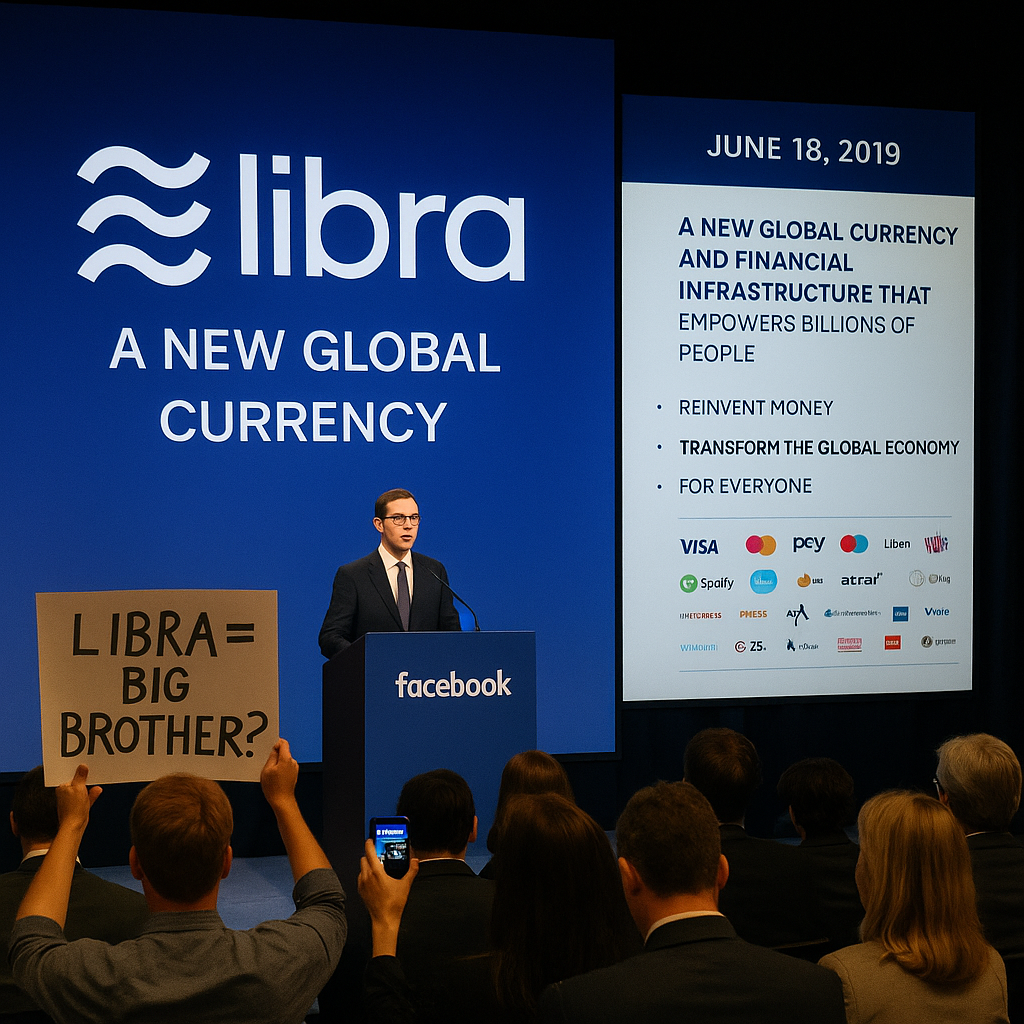Facebook Announces Libra: A New Digital Currency
On June 18, 2019, Facebook officially unveiled Libra, a digital currency designed to provide a fast, secure, and scalable global payment system — particularly aimed at the 1.7 billion unbanked people around the world. The announcement came through the release of Libra’s whitepaper, outlining a bold plan to blend blockchain technology with mass social media adoption.
The news immediately sent shockwaves through the global financial landscape. With over 2.4 billion active users, Facebook’s move into crypto wasn’t just another tech experiment — it was seen as a potential disruptor to the traditional financial system, sparking both excitement and immediate regulatory concern.
What Is Libra?
Libra is a stable digital currency, backed by a basket of low-volatility assets such as bank deposits and short-term government securities. Unlike Bitcoin, Libra is not designed to be volatile or speculative — its goal is to offer price stability and ease of use for global payments.
Key Components:
-
Built on a new blockchain developed from scratch: the Libra Blockchain.
-
Governed by the Libra Association, a consortium of founding members including Visa, Mastercard, Uber, Spotify, PayPal (at the time), and others.
-
Managed by a reserve of assets, giving each Libra token intrinsic value.
-
Intended to be used for peer-to-peer payments, e-commerce, and remittances.
Libra would be integrated with Calibra, Facebook’s digital wallet (later rebranded to Novi), allowing users to send money via Messenger, WhatsApp, or standalone apps.
Why Facebook Created Libra
Facebook cited several motivations:
-
Financial inclusion: Billions of people remain outside formal banking systems.
-
Costly and slow remittances: Libra aimed to reduce fees and friction in cross-border payments.
-
Global commerce: Enabling more seamless payments across Facebook’s platforms.
By leveraging its global scale and infrastructure, Facebook sought to “reinvent money” — offering the ease of sending a text message with the security and permanence of blockchain.
Market Reaction
The crypto community and financial markets responded with a mix of curiosity, enthusiasm, and skepticism.
Positive Views
-
Some hailed it as a turning point for crypto adoption, with a tech giant bringing blockchain to the mainstream.
-
Bitcoin prices jumped above $9,000, benefiting from the renewed media spotlight on digital assets.
-
Venture capital and fintech leaders praised Libra’s ambition, calling it a “watershed moment” for financial innovation.
Concerns and Criticism
-
Crypto purists criticized Libra for being centralized and permissioned.
-
Others saw it as a threat to monetary sovereignty, especially in developing nations.
-
Privacy advocates warned about Facebook’s data track record and the merging of financial identity with social networks.
Regulatory Blowback
Governments and regulators were quick to respond — and not with open arms.
U.S. Lawmakers React:
-
Within days, members of the U.S. Congress called for hearings.
-
Maxine Waters, Chairwoman of the House Financial Services Committee, demanded a moratorium on Libra development.
-
Lawmakers cited concerns over money laundering, consumer protection, financial stability, and privacy.
Global Pushback:
-
France and Germany called Libra a threat to sovereign currencies.
-
Central banks, including the Bank of England and European Central Bank, demanded strict oversight.
In many countries, Facebook was seen as “too big to trust” with something as sensitive as money creation.
What Sets Libra Apart From Bitcoin?
| Feature | Libra | Bitcoin |
|---|---|---|
| Backing | Basket of fiat assets | No backing (purely market-driven) |
| Governance | Libra Association (100+ members) | Decentralized, open-source |
| Volatility | Low (intended) | High |
| Purpose | Payments & financial inclusion | Store of value, censorship resistance |
| Speed & Scale | Near-instant, billions of users | Slower, constrained scalability |
Libra’s goal wasn’t to replace Bitcoin — but to build a bridge between fiat and crypto, at a global scale, with mainstream usability.
What’s Next for Libra?
As of June 2019, Facebook projected a launch in 2020, pending regulatory approval. However, the immediate backlash hinted that delays and redesigns were likely.
Key things to watch:
-
Whether major partners (e.g., Visa, PayPal) stick with the project amid scrutiny.
-
How regulators shape or restrict Libra’s design.
-
Whether the Libra Association can effectively decentralize governance.
-
If Facebook can build trust around privacy and financial data control.
Some analysts predicted that Libra might evolve into a more tightly regulated stablecoin, or be limited to select markets.
The Broader Implications
Even if Libra itself doesn’t succeed, its announcement accelerated several major trends:
-
Governments began to seriously explore Central Bank Digital Currencies (CBDCs).
-
The conversation around stablecoins moved from niche to global stage.
-
Traditional payment networks like Visa and Mastercard were forced to rethink crypto integration.
-
The crypto industry began moving toward compliance, identity, and regulation.
Conclusion
Facebook’s announcement of Libra in June 2019 was a watershed moment in the evolution of digital finance. It triggered both enthusiasm and concern — not just from crypto insiders, but from world governments and legacy institutions.
Libra may not be the final form of digital money, but it opened the door to a new era of programmable finance, mass adoption, and regulatory reckoning.
Whether embraced or blocked, Facebook Libra has already changed the financial conversation.
